Top Product-led Growth Companies
Product-led growth relies on exceptional product experiences, frictionless trials, and viral features to drive acquisition, retention, and revenue growth rather than traditional sales and marketing tactics.
Fri Sep 01Written by: Simona Liberati
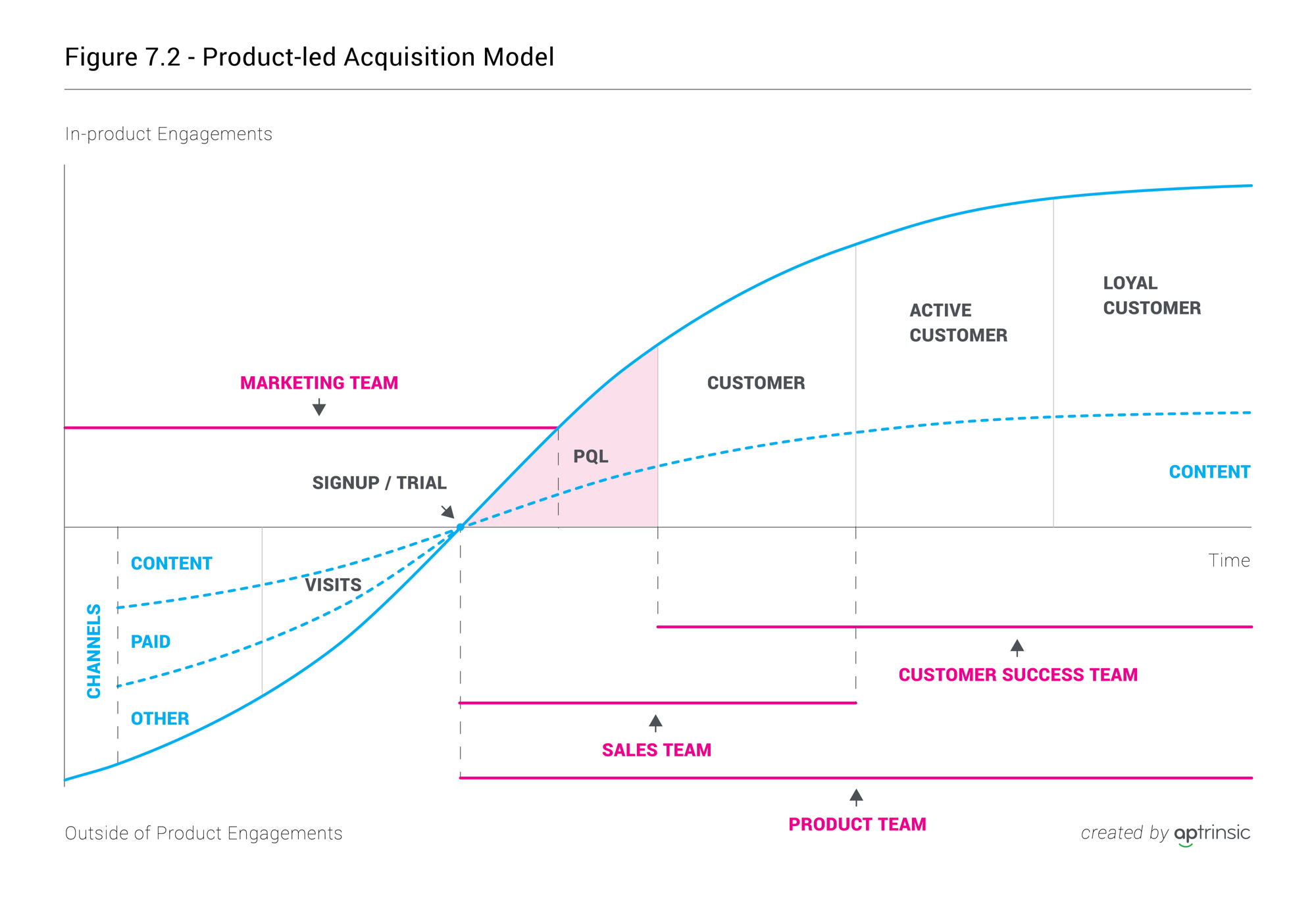
Growth is essential for any business, but relying on traditional sales and marketing tactics alone is no longer enough. Savvy companies today are embracing product-led growth (PLG) – a strategy where the product itself drives acquisition, retention, and expansion.
Below, we’ll explore some of the most successful product-led companies and the strategies they use to achieve sustainable growth.
Key Takeaways:
-
Intuitive Design Drives Adoption PLG products use clean, minimalist interfaces and thoughtful learnability to create highly intuitive experiences that make capabilities accessible to users of all skill levels.
-
Fast Time-to-Value Builds Confidence Optimizing to deliver core value within the shortest time from signup builds user confidence in the product’s benefits and propels further engagement.
-
Viral Loops Encourage Organic Growth PLG products incorporate viral sharing features like frictionless content distribution and seamless collaboration to spur organic adoption and network effects.
-
Personalization Deepens Loyalty Personalized experiences based on individual user data and preferences make PLG products feel more tailored and responsive, driving satisfaction.
So what exactly is product-led growth?
PLG is a model where product usage and engagement directly influence business growth, rather than relying heavily on sales and marketing efforts. The product itself convinces customers of its value, rather than marketing messages.
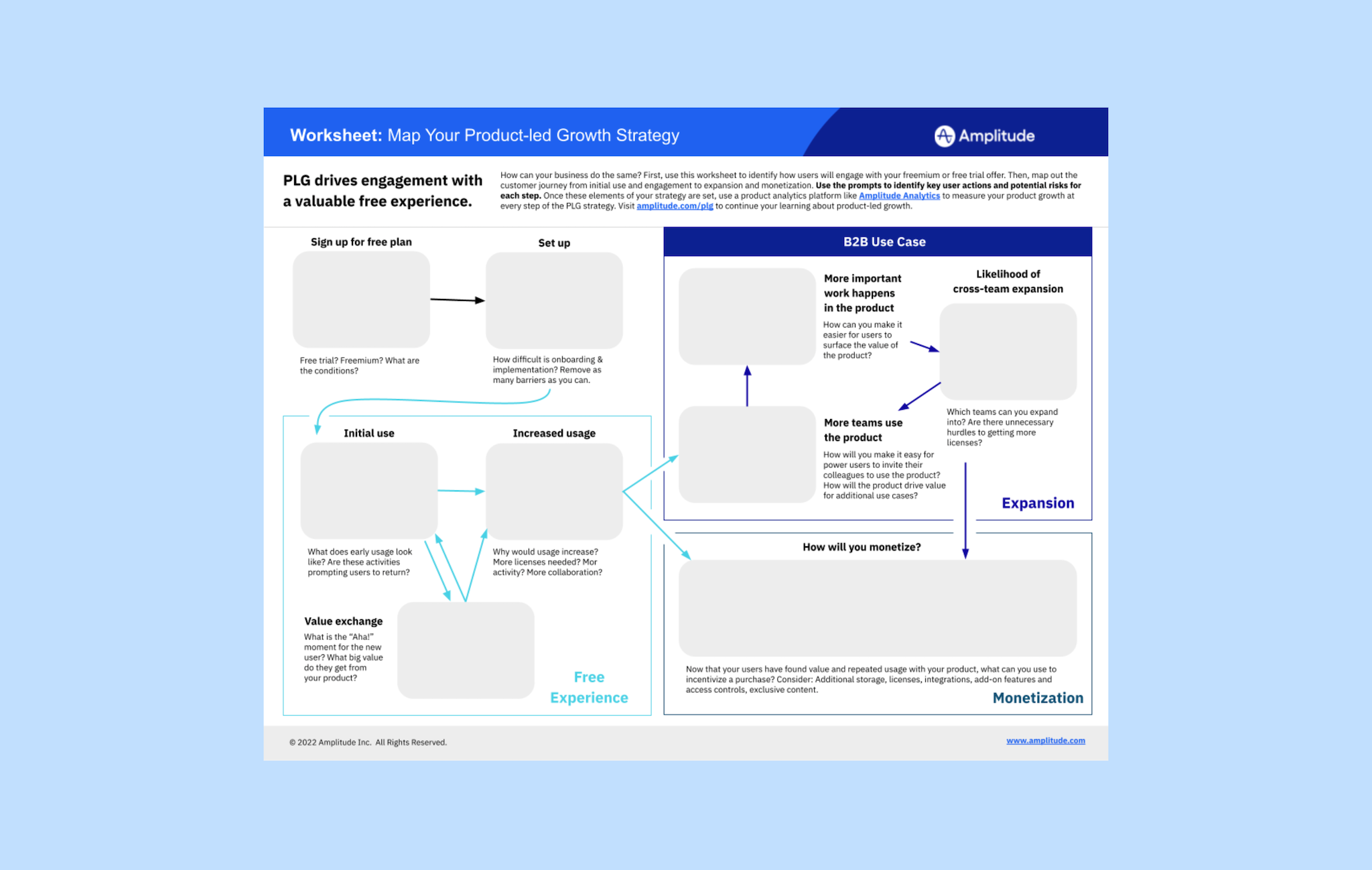 Download the PLG map worksheet
Download the PLG map worksheet
While sales and marketing play a key role in generating awareness and interest, a PLG motion ensures that once a lead engages with the product, exceptional user experiences drive conversion, retention, and expansion.
The most successful PLG companies often share these traits:
- Aligned Goals Alignment across departments and exceptional product design are hallmarks of top PLG companies.
- Usable Intuitive, seamless product experiences that clearly convey value from the start. Prospects can quickly see how the product will benefit them.
- Self Service Frictionless exploration and onboarding. Free trials, freemium tiers, and easy sign-ups allow prospects to experience benefits first-hand.
- Virality Growth Virality features that encourage sharing and collaboration to grow the user base.
- Network Effects Effects Network effects where the product’s value increases as more users join the platform.
- Reduce CAC PLG enables businesses to reduce customer acquisition costs and spend less on traditional sales and marketing.
In short, PLG puts the product at the heart of growth. When done right, it enables sustainable business growth and higher customer lifetime value.
Intuitive design and seamless functionality
PLG products have simple, easy-to-use interfaces that are accessible for users of all skill levels. Features are designed for maximum usability rather than complexity. For example, Notion’s flexible workspace and drag-and-drop creation simplifies working with content.
Product-led growth companies understand that intuitive, seamless design is critical for driving adoption and retention. Their products have simple, easy-to-use interfaces that are accessible for users across skill levels.
Rather than packing the interface with complex features, they optimize for maximum usability. Key elements of intuitive PLG product design include:
-
Clean, uncluttered interfaces using minimalist layouts. This removes visual distractions and complexity that may overwhelm new users. For example, Notion uses ample white space and clear visual hierarchy.
-
Easy discoverability of key features and functions. Core workflows are visible and accessible through smart IA and navigation. Notion places creation and content blocks front and center.
-
Drag-and-drop interactions that simplify complex tasks. For instance, Notion’s block-based editor lets users quickly build content by dragging and dropping elements.
-
Thoughtful learnability through progressive disclosure of advanced features. Power users can access more capabilities once they understand the basics.
-
Contextual assistance like tooltips and in-app messaging that guide users.
-
Consistent UX patterns across the application following established conventions. This makes exploration more intuitive.
-
Fast performance with all interactions optimized for speed. Reduced loading times keep users engaged.
-
Responsive, mobile-friendly interfaces enabling access from any device.
The result is a smooth, frictionless experience where both new and seasoned users can be productive. Products feel instinctive rather than requiring heavy learning. This drives the engagement and retention needed for PLG.
Clear value communication
During onboarding and the initial experience, PLG products quickly convey core value propositions and benefits through tooltips, in-app messaging, prompts, and frictionless workflows. For instance, Slack’s bot-guided onboarding shows new users how to create channels, send messages, and integrate apps within minutes of signing up.
Onboarding and the initial experience are critical moments for PLG products to clearly communicate their core value proposition. Successful PLG products use various techniques to highlight benefits and convey “aha” moments early on:
-
Introductory tooltips and overlay instructions that walk new users through primary workflows step-by-step. For example, Slack provides tips for setting up channels, sending messages, and inviting teammates.
-
In-app messaging that educates users on key features. HubSpot uses callouts to explain different dashboard elements and views.
-
Proactive prompts that suggest high-value actions to users, like integrating complementary apps. Slack prompts users to connect other workplace tools like Google Drive and Trello.
-
Simplified, frictionless workflows that allow new users to accomplish meaningful tasks quickly. For instance, Calendly’s workflow has users scheduling appointments in seconds.
-
Pre-built templates, playbooks, and examples that let users easily create high-quality output. Notion provides templates for wikis, trackers, and databases.
-
Personalized recommendations for features and workflows based on user traits. Intercom tailors onboarding based on customer data.
-
Progress trackers and checklists that provide direction and celebrate milestones.
-
In-product announcements and event highlighting major new features or activities.
The goal is to immediately highlight the “aha” moments and wins that convey the product’s most compelling benefits. Users build confidence in the product’s value early on, rather than struggling to understand it.
Short time-to-value
PLG product teams optimize to reduce the time from signup to a user experiencing value, known as time-to-value. For example, Calendly’s integration with calendar apps has users scheduling appointments within seconds, quickly highlighting the core value. The faster a user gets value, the more likely they are to convert and become engaged long-term.
Growth teams deliberately design and optimize the initial workflows to create quick time-to-value moments, such as:
-
Integrations and connectors that allow new users to easily connect their existing tools and data sources to start deriving value immediately. For example, Calendly integrates with major calendar apps so users can begin scheduling appointments in seconds.
-
Pre-built templates and examples that new users can customize for their needs versus starting from scratch. Notion provides templates for common use cases like wikis, trackers, and databases to accelerate time-to-value.
-
Personalized recommendations and suggested actions based on data and usage patterns to point users to high-value features. Netflix recommends relevant shows and movies based on viewing history and signals.
-
Streamlined workflows that allow common tasks to be completed in the fewest steps possible, often through thoughtful defaults. For instance, Clearbit’s enrichment workflow needs minimal configuration out of the box.
-
Proactive in-app messaging that educates about key “aha” moments and capabilities early in the experience.
-
Intuitive interface and interactions that minimize the learning curve.
-
Contextual help and assistance to unblock users and keep them progressing.
Delivering value quickly during onboarding and the initial experience gives users confidence in the product’s benefits. This propels further engagement and retention.
Personalization
72% of customers expect personalized experiences, and PLG products deliver. Features like tailored recommendations, saved preferences, and customizable interfaces cater to individual needs. For example, Spotify’s Daily Mix playlists learn from listening patterns.
Here’s an expanded version of that section on personalization:
-
Tailored recommendations based on user data and usage patterns. For example, Spotify’s Daily Mixes are personalized playlists based on an individual’s listening history.
-
Individual user preferences and settings that can be configured. Zoom allows customizing video layouts, virtual backgrounds, and other options.
-
Adaptive interfaces that change based on user traits and roles. HubSpot shows different dashboard components to sales vs marketing users.
-
Onboarding flows adapted to the individual user’s needs and level of expertise. Walkthroughs can be more expansive for beginners vs power users.
-
Segmentation of users into groups for more targeted in-app messaging and campaigns. Intercom, Mailchimp and others leverage user segments.
-
Personalized notification schedules adapted to individual usage cadence rather than generic blasts.
-
Integration with CRM data for known customer info like name, company, role etc. Salesforce integrations leverage this.
-
Private sandboxes or workspaces where users can customize workflows or save preferences. Notion’s workspaces keep spaces personalized.
-
Automated triggers customized to events relevant for that user, like introductory tips for fresh users.
-
Consistent UX that carries over personalizations across platforms and devices.
Personalization makes the product experience feel more responsive to users’ unique needs. This helps drive individual engagement, satisfaction, and retention in PLG models.
Frictionless exploration
PLG products enable easy exploration through free trials, freemium tiers, and usage-based pricing. No sales rep involvement is needed to explore. Zoom provides free 40-minute video calls to get users hooked. PLG products enable frictionless exploration for prospects to experience the product’s value firsthand. Common techniques include:
-
Generous free trials with access to core features - often 14-30 days. Calendly and Slack offer robust trials.
-
Freemium tiers with free access to high-value features, only limiting advanced capabilities. Zoom provides free 40-minute video calls.
-
Limited-time access passes like 7-day bootcamps or temporary demo accounts. Experiencing value builds interest.
-
Usage-based or consumption pricing so users only pay for what they use. Twilio charges per API call.
-
Access to free or “lite” versions with essential functionality. Canva’s free graphic design version drives adoption.
-
Sample content or project examples users can explore before signing up. Figma allows viewing sample files.
-
Public sandboxes to build and test projects with dummy data before committing. Stripe provides test payment integration.
-
Guest access features to invite non-users to collaborate without signup. Google Drive enables this.
-
Passwordless sign-up using magic links, Google/SSO etc. to eliminate signup friction.
-
No sales rep involvement needed for exploring. Self-serve signups let users try immediately.
The goal is to remove any hurdles that slow down prospects from experiencing that initial value. Generous trial periods and freemium access help demonstrate the solution benefits, converting users.
Viral sharing and collaboration
PLG products encourage organic sharing and collaboration. Dropbox enables easy content sharing via link, while Github lets developers collaborate on projects. More xamples include:
-
Frictionless content sharing via simple link or embed for non-users. Dropbox’s shareable links and Figma’s embed capabilities enable this.
-
Comments, @mentions and activity feeds to notify others and loop them in. Notion pages can be discussed through built-in comments.
-
User-to-user referral and invite capabilities to spread awareness. Dropbox offers referral bonuses.
-
Public galleries, profiles or project pages to showcase work and drive interest. Dribbble and Behance do this for designers.
-
Integration with social media channels to enable sharing to networks. Canva simplifies social media image creation.
-
Co-editing abilities in real-time for gathering feedback. Google Docs shows this in action.
-
Project management workflows to easily assign tasks and manage collaboration. Asana enables team-based workflows.
-
Chat/messaging capabilities to encourage user-to-user engagement. Slack is built around messaging.
-
Events/community programming to foster interactions between users. Product Hunt Ship allows users to host live events.
-
App marketplaces and integrations to connect complementary tools. Zapier’s integration network creates bonds.
Viral features turn users into advocates and evangelists for the product, propelling organic growth through sharing, referrals, and network effects.
Network effects:
PLG products exhibit network effects where value grows as more users join. For instance, Slack and Trello become more useful as more teammates are added, as more teammatest join, the productivity value increases for all users. Features that drive network effect value include:
-
Communication/messaging - The more users join, the more useful the messaging capabilities become. WhatsApp demonstrates strong network effects.
-
Marketplaces and ecosystems - App integrations, plugins, and third-party add-ons increase the value for all users as more are added. Shopify is a prime example.
-
Social connections - As users invite friends or connect to existing contacts, the value grows via expanded social graphs. LinkedIn jobs leverage network connections.
-
Content sharing - Every new user can contribute valuable content and knowledge that enriches the platform. Wikipedia and Quora benefit from user-generated content at scale.
-
Data and signals - More users contributing data points enhance personalization, recommendations, and insights for everyone. Waze gets better with more user data.
-
Reviews and reputation - The credibility and usefulness of reviews, ratings and reputation systems compound as more users contribute. Yelp and Airbnb depend on cumulative opinions.
-
Matchmaking - Value increases with more users on both sides of a marketplace match. Uber, Lyft, and dating apps exhibit this dynamic.
Notion
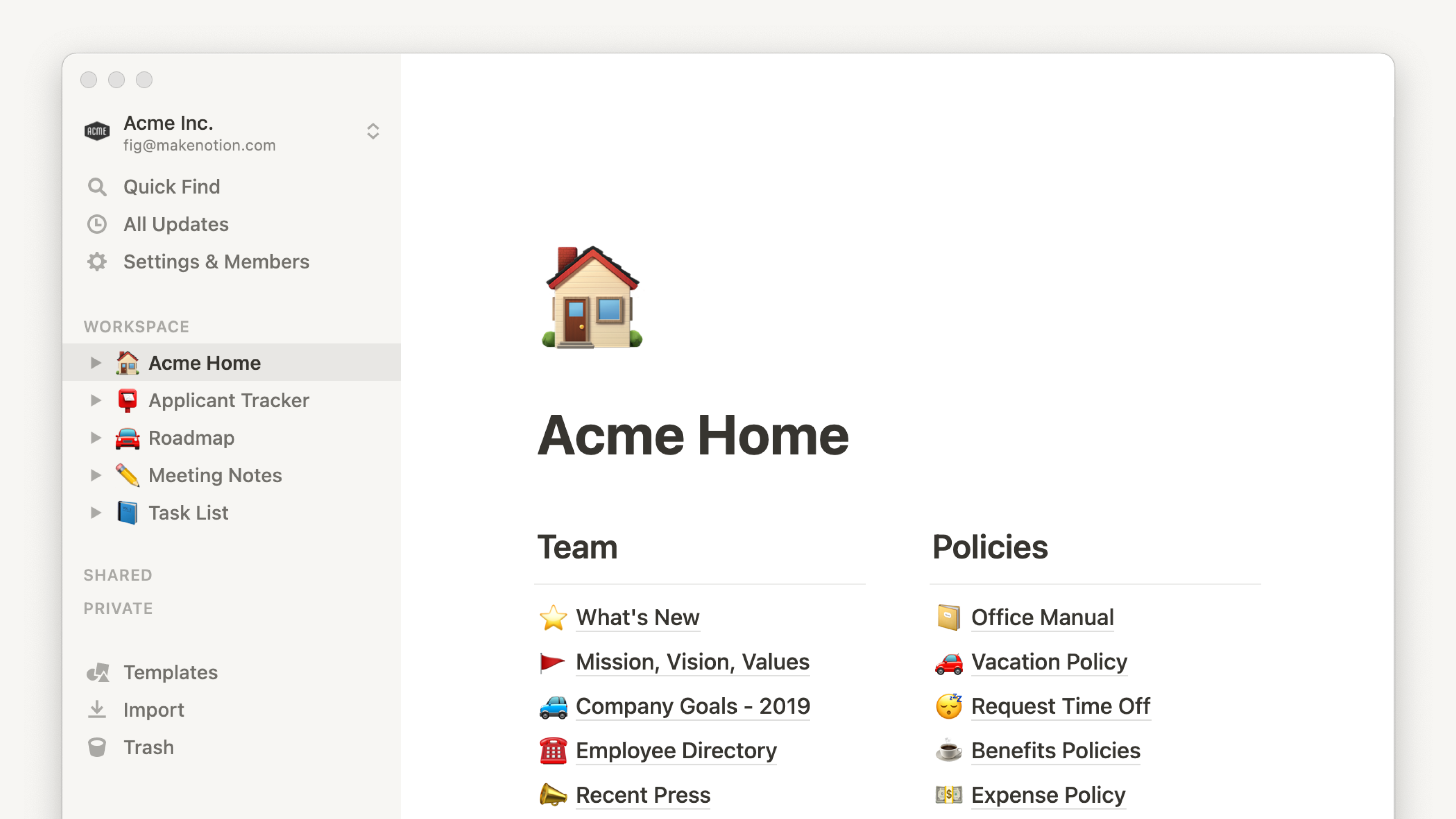
Notion is the quintessential example of a product-led SaaS company. Their visual, modular workspace simplifies working with content and data for teams and individuals.
Notion’s secret sauce is their simple drag-and-drop interface that makes even complex projects and workflows accessible to non-technical users. The building blocks are flexible enough to support personal task management, team knowledge bases, APIs, and more.
Onboarding guides new users through core features like page creation, databases, and team workspaces via tooltips and prompts. Useful templates for wikis, trackers, and schemas accelerate time-to-value so users quickly create robust systems on Notion.
Public publish and toggle view features allow users to easily share pages, databases and docs through links. Password protection options enable sharing beyond the user base. Notion’s embeds and web clips also allow content to go viral.
The responsive mobile and desktop apps sync seamlessly, with offline access removing friction. Third-party Zapier integrations further the power of Notion’s databases.
While viral sharing and savvy marketing fueled early growth, Notion’s growth flywheel has been powered by word-of-mouth and the platform’s intuitive approach that delights users. The product itself drives viral adoption and retention.
Notion recently launched modular APIs to allow developers to build apps and automations on their platform. This unlocks even more potential network effects and extensibility powered by engaged users and partners.
Overall, Notion has done an exceptional job at product-led growth, with over 20 million users onboarded through frictionless exploration, intuitive design, and viral sharing capabilities.
Miro
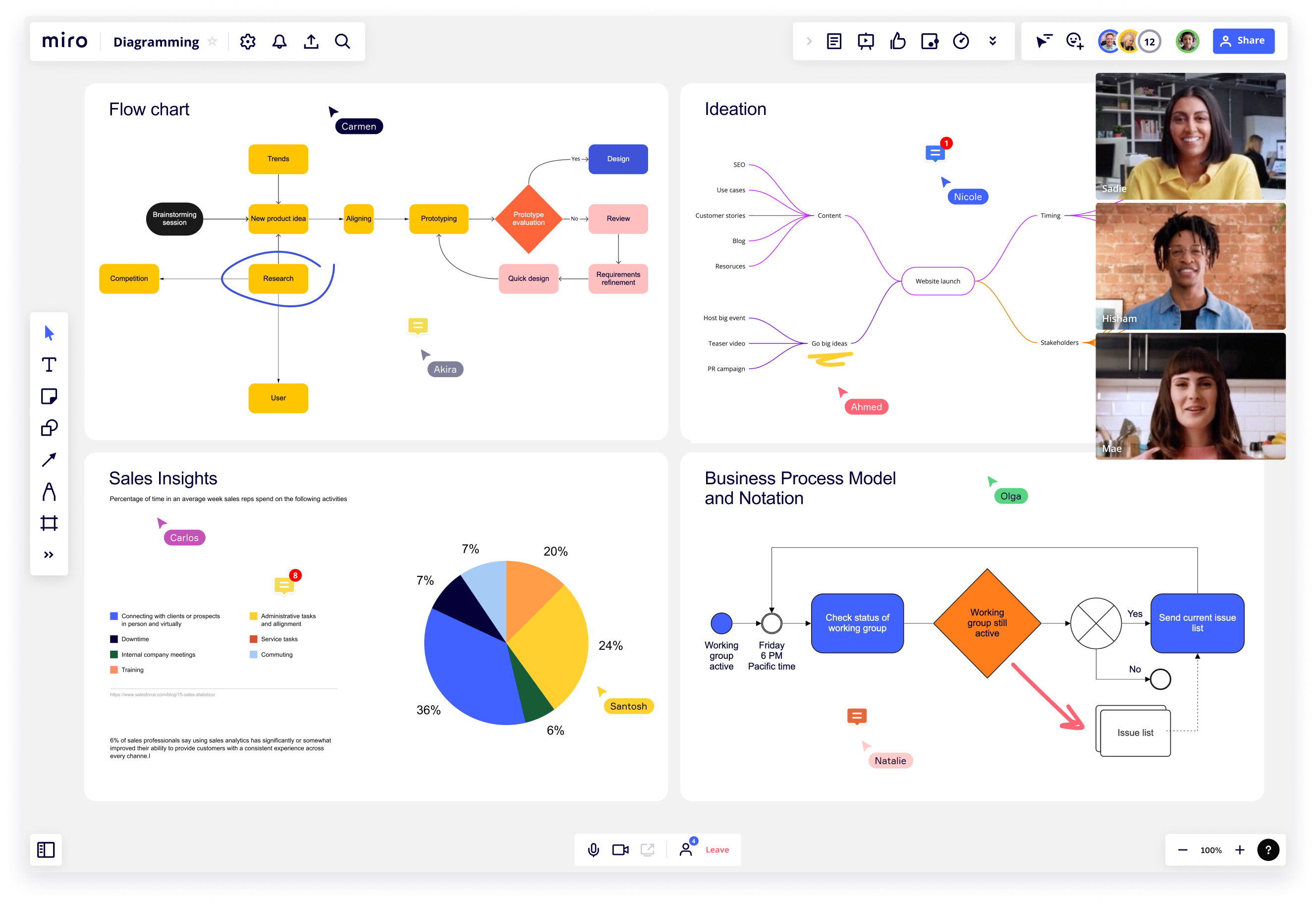
Miro is a leading digital whiteboarding and visual collaboration platform used by over 30 million users globally. Their product-led strategy focuses on driving viral adoption and collaboration through their freemium access and intuitive creation tools.
Miro offers a generous free tier so users can easily experience the value of real-time visual collaboration. Template galleries and libraries accelerate onboarding with pre-built boards for common use cases like brainstorming, design sprints, and mapping customer journeys.
The intuitive drag-and-drop canvas makes it effortless for teams to co-create flows, diagrams, wireframes and more. Inline comments, @mentions, and seamless video conferencing foster collaboration and alignment.
Public and private sharing links allow teams to easily distribute boards for feedback from coworkers or clients. Miro enables presenter views, allowing discussion to happen in real-time around a board.
Miro also leverages an engaged user community, online events, and social channels to highlight team success stories and workflows. This cultivation along with their integration ecosystem exhibits strong network effects where value scales with users.
The viral nature of their freemium model and intuitive real-time collaboration capabilities has fueled rapid organic growth for Miro. Product usage itself drives adoption as teams experience the benefits firsthand.
Linear

Linear is an issue tracking and project management tool aimed at software teams. Their product-led strategy focuses on frictionless onboarding, transparent pricing, and integrations to drive viral adoption.
Linear offers a free starter plan so developers can immediately experience the value of consolidating issue management into a single tool. This removes friction in getting started.
Native integrations with tools like Slack, GitHub, and GitLab centralize notifications and traceability between Linear and developers’ existing workflows. This makes issue tracking more seamless.
Public issue links allow any Linear user to easily share tickets outside their team for transparency or to gather feedback. This viral sharing capability helps spread product usage.
Linear also emphasizes transparent, no-surprises pricing without long-term contracts. Users can choose the plan that fits their needs as they scale. A clean UI simplifies getting started.
An upcoming Open API will enable developers to build custom integrations and automations with Linear, further enhancing capabilities. This exhibit network effects, improving value as integrations grow.
Through integrations and viral sharing, Linear has onboarded over 20,000 development teams to their issue tracking product. The platform itself drives retention and growth.
Slack

Slack is the leading business communication platform used by millions of users globally. Their product-led strategy focuses on easy onboarding, seamless integrations, and viral collaboration.
Slack onboards new users through friendly bot-guided tutorials that provide tips on setting up channels, messaging, integrating apps, and more. This gets users collaborating quickly.
Robust notification features across devices and interactive message formatting make conversations highly engaging. Integrations with popular tools like Google Drive, Salesforce, and Zoom make the value immediately clear.
Public sharing links allow any Slack user to easily distribute channels externally to those outside their workspace. Guest access features let teams collaborate with external partners in channels through frictionless invites.
Slack Connect enables direct messaging between users across different organizations, facilitating communication. Slack’s robust API platform also enables developers to plug in custom apps and bots to automate workflows.
Slack’s rapid growth to over 12 million daily active users has been fueled by viral, bottom-up adoption from teams finding immediate utility in the platform. Frictionless sharing capabilities help spread usage quickly across departments and organizations.
Figma
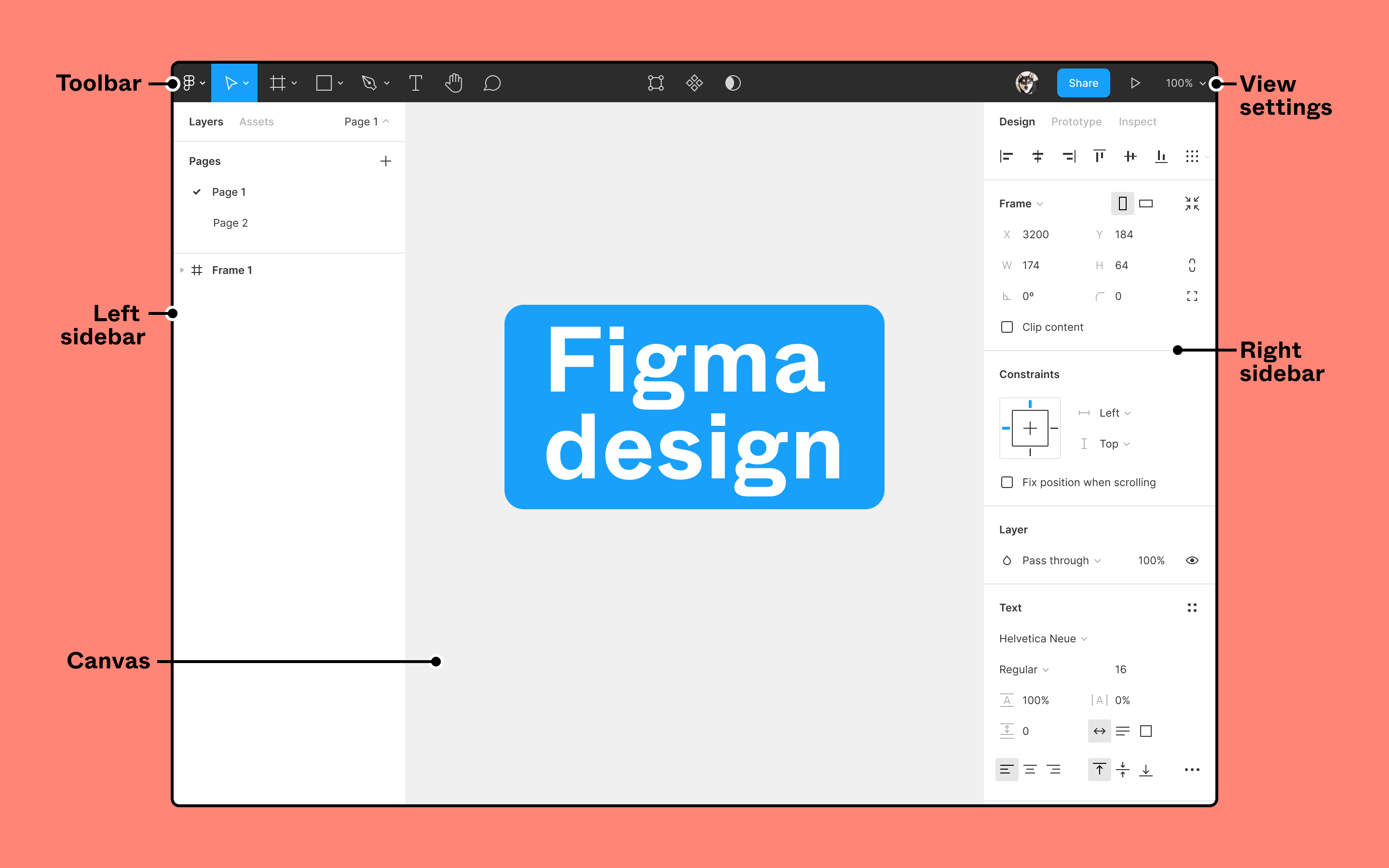
Figma has emerged as a leading web-based design platform through viral product experiences and frictionless collaboration.
Figma allows designers to freely explore and inspect design files without needing to create an account first. This lets potential users experience the value before signup.
Their multiplayer editing environment enables seamless real-time collaboration on designs. Designers can simultaneously work on the same files and see edits appear instantly.
Reusable component libraries and design systems make it easy to maintain consistency at scale. Published libraries enable organization-wide access.
Project, file, and prototype sharing via links lets designers easily collect feedback from stakeholders outside their organization. Figma Community profiles and galleries make it simple to showcase work.
Figma also enables whiteboarding, interactive prototyping, and wiggle animations right in the platform. Third-party plugins from their API platform enhance capabilities further.
This frictionless collaboration environment has fueled Figma’s viral adoption among designers and teams. The product experience itself drives retention as users become immersed in the multiplayer editing capabilities.
Figma has experienced incredible growth. They have over 4 million users from companies like Airbnb, Uber, and Twitter. Their product-led approach has enabled scaling rapidly.
Dropbox
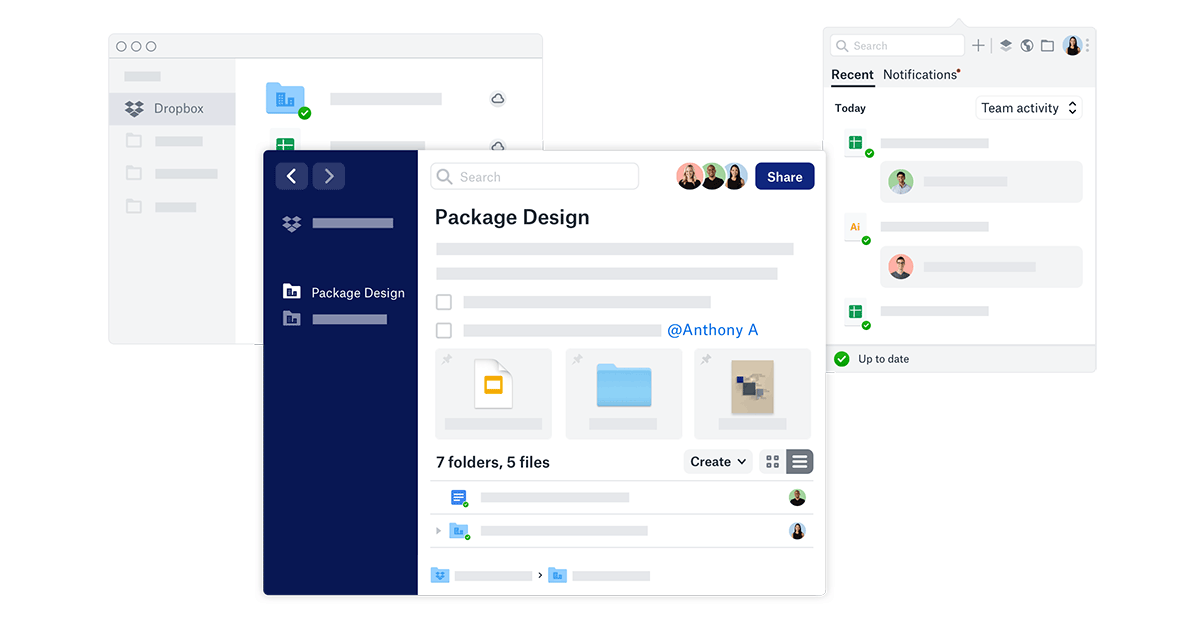
Dropbox pioneered simple cloud file storage and syncing for consumers and businesses. Their product-led strategy is defined by frictionless sharing, seamless syncing, and viral referral programs.
Dropbox offers a generous free tier so users can quickly experience the core value of cloud backup and file access across devices. Syncing across desktop, mobile and web eliminates friction.
Easy file sharing via password-free links enables sharing folders or files not just with other Dropbox users, but anyone. This allowed Dropbox to grow virally, with users sharing files externally.
Referral programs such as referral bonuses and extra storage for referrals fueled viral adoption early on. These programs incentivized users to share Dropbox.
For teams, Dropbox Business provides centralized administration, sharing permissions, remote wipe, and enterprise integrations. Sync makes team collaboration seamless.
Almost 500 million users have adopted Dropbox through viral, bottom-up sharing of files and folders externally. Their product experience made cloud file storage effortless at scale.
Atlassian
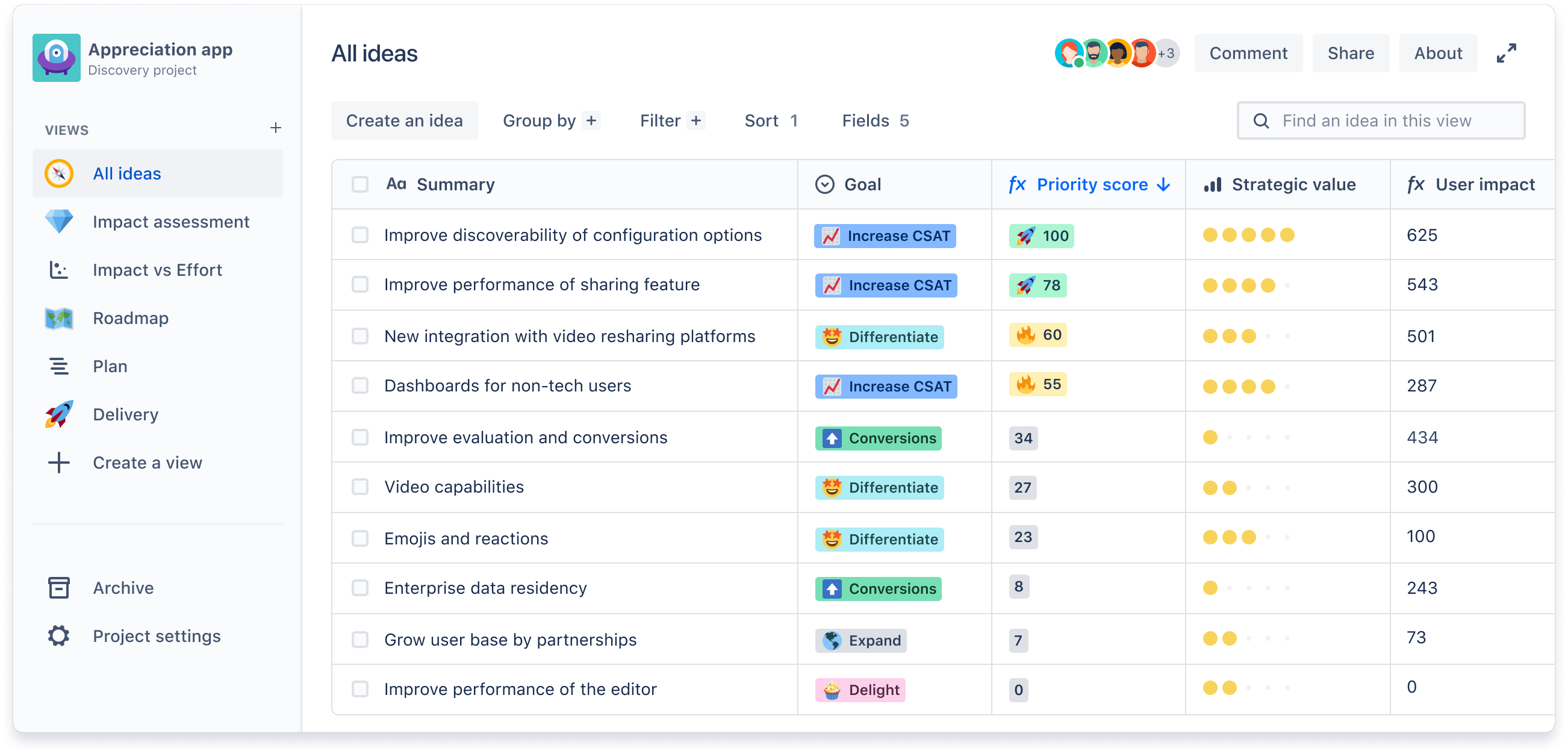
Atlassian has built a suite of popular project management and collaboration tools like Jira, Confluence, and Trello used by over 200,000 companies worldwide. Their product-led strategy centers around viral adoption, extensibility, and network effects.
Atlassian offers free or low-cost versions of their products like Jira Software and Confluence Cloud to help users experience value before committing. This makes onboarding frictionless while showcasing Atlassian’s benefits.
Their Marketplace of over 5,000 third-party apps created by developers enhances Atlassian’s core products with new capabilities. The growing Marketplace library increases the value for all users.
Atlassian’s products were also built to be easily configurable and customizable to adapt to various team needs and workflows. Open APIs allow teams to build custom automations and extensions.
This extensibility and integrations ecosystem has helped Atlassian spread virally between teams and departments. Jira’s project management capabilities made it a hit with agile engineering teams early on.
Atlassian now powers over 200,000 organizations with viral, bottom-up adoption of their customizable tools optimized for product-led growth.
Amplitude

Amplitude is a leading product analytics platform used by companies like Microsoft, Paypal, and Peloton to understand user behavior. Their product-led strategy is centered around frictionless onboarding and viral data sharing.
Amplitude offers a free tier so any user can access core behavioral analytics like funnel, retention, and cohort analysis without a credit card. Easy implementation with SDK, APIs, or UI accelerates time-to-value.
Out-of-the-box dashboards, metrics, and charts allow new users to quickly uncover insights and showcase value. User segmentation simplifies drilling into behavioral analysis.
Public dashboard links enable anyone at an organization to easily embed and share dynamic charts and analysis externally without granting platform access. This viral data sharing helps spread Amplitude usage internally.
In-app notifications, tooltips, and documentation guide users through high-value capabilities in a self-serve manner. The product experience drives retention.
Through their viral data sharing and self-serve analytics capabilities, Amplitude has onboarded over 59,000 paying customers including forwarding-thinking digital companies.
Hotmail
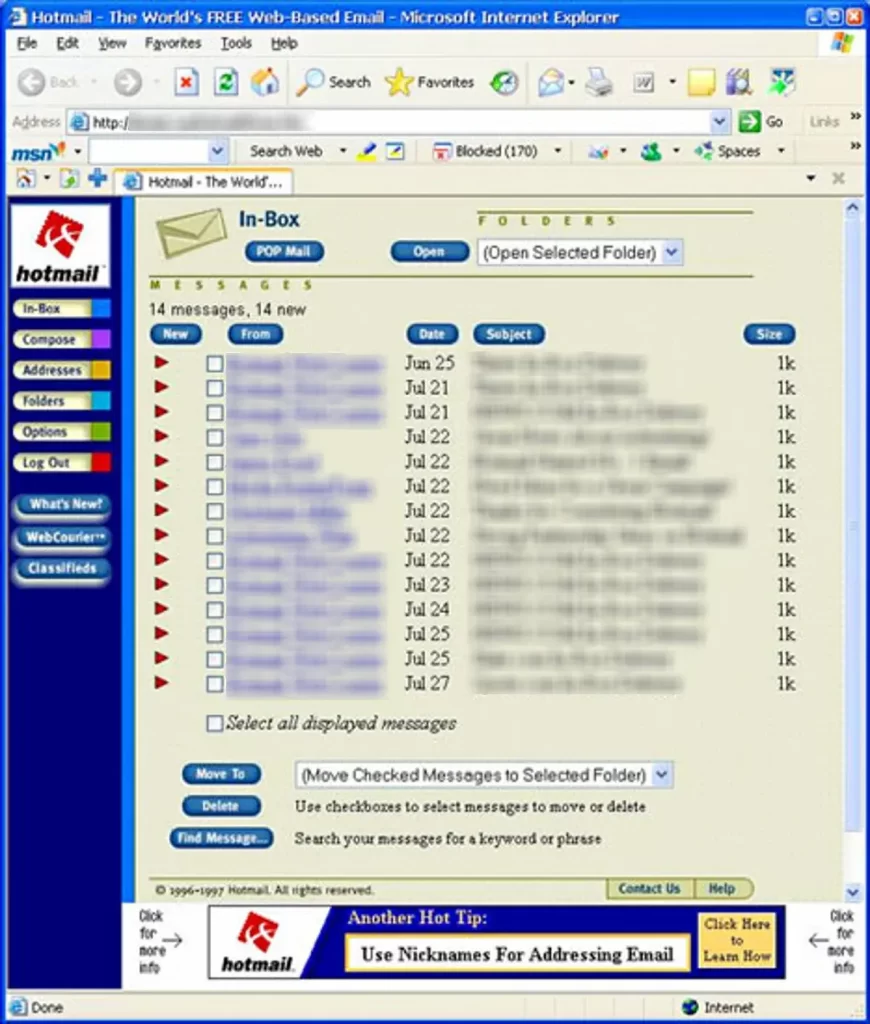
Hotmail was one of the first web-based email services, pioneering the concept of free webmail in the mid 1990s. Their product-led growth strategy focused on virality and ease of access.
A key innovation was Hotmail’s invite/referral system where existing users could send contacts invites to create accounts via unique links. This built-in viral loop helped Hotmail acquire users rapidly.
Hotmail also emphasized quick, frictionless signup with no lengthy forms to complete. New users could start using webmail instantly.
The service was platform agnostic and accessible via any web browser. This was novel in the era of needing specialized email software. The seamless access helped Hotmail spread.
Hotmail carved out a new positioning as free, web-based email when competitors were paid services or desktop clients. The value proposition resonated with early web users.
Within 18 months of launch, Hotmail had rocketed to over 8 million users. This was an early demonstration of how viral product capabilities could drive growth.
Microsoft acquired Hotmail in 1997, impressed by their innovation in viral, product-led growth. They set the blueprint for many SaaS companies to come.
What’s next for PLG
Product-led growth has clearly emerged as a winning strategy for modern software companies looking to drive sustainable business growth. While traditional sales and marketing tactics still have merit, putting the product at the center of acquiring, retaining, and expanding accounts is a proven formula.
As we’ve explored, successful PLG companies share common traits like intuitive interfaces, fast time-to-value, viral sharing capabilities, and personalized experiences. These product capabilities themselves convince users of the value and benefits, rather than direct selling motions.
Significant technology shifts have enabled the rise of PLG in recent years. Broadband internet access provides the infrastructure for cloud-based software delivered through browsers. Mobile apps and platforms took this even further.
Digital transformation across businesses and consumer behavior also set the stage for viral, bottom-up software adoption. When people can easily try apps at scale, products can sell themselves.
Looking ahead, no-code tools will further accelerate PLG adoption by making it easier than ever to build great products with viral hooks. AI-powered personalization will deepen engagement and loyalty.
While PLG isn’t universally applicable, it is undoubtedly more than just a trend. Dropbox, Slack, HubSpot, and other pioneers have proven that product-led growth can disrupt industries. Incumbents will need to adapt to this software-eat-software world.
We’re likely still in the early innings of broader PLG adoption across verticals. As more companies shift resources from traditional sales and marketing to excellent product teams capable of crafting viral user experiences, PLG motions will become unstoppable growth engines.